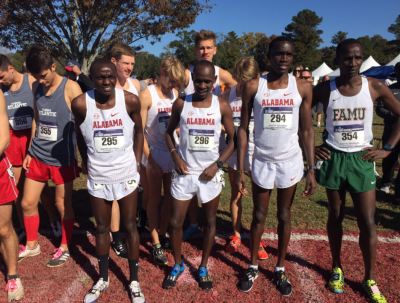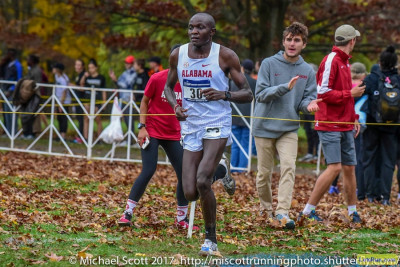Alabama’s Gamble: Can the Crimson Tide Win the NCAA Cross Country Title With Five Kenyans — And Not Much Else?
By Jonathan Gault
September 27, 2018
In November 2017, Dan Waters, the head track and field/cross country coach at the University of Alabama, bumped into Martin Smith, his counterpart at Iowa State, on the start line of the NCAA Cross Country Championships in Louisville. Alabama’s Kenyan trio of Gilbert Kigen, Vincent Kiprop, and Alfred Chelanga had rolled through the competition at the Crimson Tide’s first five meets that fall, and Smith, who coached Wisconsin to a pair of national titles in the ’80s, had taken notice.
“Looks like you guys are gonna have a good team — add a couple more pieces next year and it should be pretty exciting,” Smith told Waters.
“I was like, ‘Ah, Martin, I really can’t do that,'” Waters recalls. “‘We really want a well-rounded team [in both track & field and cross country], I just can’t sink a couple more scholarships into cross country.'”
In Louisville, Kigen (4th overall), Kiprop (7th), and Chelanga (37th) ran like studs, but the Crimson Tide’s next finisher crossed the line in 223rd place, over two minutes behind Chelanga. Alabama finished 14th as a team, but with Kigen, Kiprop, and Chelanga all returning in 2018, the nucleus of a title contender was in place.
Waters thought about what Smith said, and in March, he took a weeklong trip to Kenya. And as Waters watched a group of young athletes kick up dirt during a track workout in Eldoret, the potential answers to his team’s problems at the #4 and #5 spots ran by him. There was Noel Rotich, an 8:32 steeplechaser. There was Kwemoi Ndiwa, an 800 specialist (1:49) with terrific speed (47 seconds for 400 on a dirt track). And there were a couple more guys who had run around 8:30 for 3000 at altitude who projected as true distance men.
Waters’ goal is for Alabama to be as competitive as possible in every championship it competes in — SECs and NCAAs in cross country, indoor, and outdoor track & field. And in 2017-18, no program was more competitive than Alabama — the Crimson Tide won the John McDonnell Program of the Year award, which goes to the school with the best combined finish across cross country, indoor, and outdoor track & field (in addition to its 14th-place finish at NCAA XC, Alabama finished ninth at NCAA indoors and tied for fifth at NCAA outdoors). So when Waters decides whether to use a scholarship on an athlete, he has to ask himself a question: How much value is this guy adding? And in the spring of 2018, that question was causing headaches.
It was an easy call to offer Rotich a scholarship; not only would he provide crucial depth in cross country, but he would also immediately make a huge impact in track as one of the country’s best steeplers — no collegian ran faster than 8:30 last spring. But Waters was not sure what to do after that.
Option #1: Waters could offer a scholarship to one of the true distance guys in the hopes that he could develop into the missing fifth piece of a potential NCAA title-winning cross country team.
But on the track, the returns would be limited: Kiprop, Chelanga, and Kigen had gone 1-2-3 in the 10,000 at SECs and 1-3-4 in the 5,000. Spending another scholarship on a distance runner who could finish fourth or fifth at conference offers less value than spending it on a stud in another event who could finish first or second. And even if the distance guy panned out, there’s no guarantee that would result in an NCAA title. Northern Arizona returns three men from last year’s top 10 at NCAA XC; the Lumberjacks’ top two, Matt Baxter and Tyler Day, both finished ahead of Kigen, Alabama’s #1.
Option #2: Waters could offer a scholarship to Ndiwa, who would fill a hole for Alabama in the 800, and hope that he possessed the strength to fill in as the team’s #5 man in cross country.
“He’s run 25:35 [for] 8k cross in Kenya,” Waters says. “Is that good enough? I don’t know. You tell me.”
Option #3: Waters could elect not to offer a second scholarship to any runner at all.
This decision would torpedo any hopes of the Crimson Tide contending for the national title, but it would free up money to use on another sprinter or field eventer.
In the end, Waters decided to offer the 800-meter man Ndiwa a scholarship, but even now, he’s not sure if he made the right decision. While Rotich has stepped in seamlessly, running stride-for-stride with the Crimson Tide’s three returning All-Americans, Waters still doesn’t know what to expect from Ndiwa. And if Ndiwa doesn’t pan out, the Crimson Tide’s #5 man will likely be JP Brinyark, a 14:41 5,000 runner who finished 243rd at NCAAs last year. Alabama’s title hopes are riding on Ndiwa’s legs.
“Ndiwa, we’re asking him to stretch pretty far,” Waters says. “From an 800-meter guy all the way up to 10,000 over cross is a pretty big difference. And there’s obviously been guys that have been able to do it. We’ll just have to see how it goes…
“I didn’t make the decision to scholarship Noel or to scholarship Ndiwa because of cross country. We put them on the roster because Noel is a great steepler and Ndiwa is a great 800-meter runner. We probably could have taken guys that were cross country guys or 10k guys [but] we decided to round the team out and fill holes, which is causing me great stress today.”
Waters believes that he made the right call — “hopefully when it comes to indoor and outdoor, the decision becomes pretty clear” — but there are still moments when he allows himself to ponder what might have been had he used one more scholarship into a pure distance guy.
“I sit here and think, Gosh, did I make a mistake? Should I have gone for this?”
***
Should Alabama win the national title this year, it would buck a trend that has seen “distance schools” — the ones that allocate almost all of their 12.6 men’s track and field/cross country scholarships to distance runners — win the last nine national titles. During that span, only one school — Oklahoma State in 2012-13 — has managed to finish in the top 10 at NCAA indoors or outdoors during the same year it won NCAAs in cross. Only three schools during the last nine years — Syracuse in 2015-16, Oklahoma State in 2012-13, and Wisconsin in 2011-12 — have even scored points at NCAAs in a non-distance event the same year that they won NCAA XC, as shown in the table below.
| Year | School | Indoor place | Indoor points (non-distance) | Outdoor place | Outdoor points (non-distance) |
| 2017-18 | Northern Arizona | 15th | 14 (0) | T-20th | 14 (0) |
| 2016-17 | Northern Arizona | T-58th | 1 (0) | T-69th | 2 (0) |
| 2015-16 | Syracuse | 11th | 16 (8) | T-47th | 5 (5) |
| 2014-15 | Colorado | T-28th | 7 (0) | T-51st | 4 (0) |
| 2013-14 | Colorado | T-32nd | 6 (0) | T-64th | 2 (0) |
| 2012-13 | Oklahoma State | 8th | 20 (5) | T-65th | 2 (0) |
| 2011-12 | Wisconsin | T-26th | 8 (8) | 32nd | 9 (0) |
| 2010-11 | Oklahoma State | N/A | 0 (0) | N/A | 0 (0) |
| 2009-10 | Oklahoma State | T-60th | 1 (0) | T-33rd | 8 (0) |
There’s no “right” or “wrong” way to build a program. Every school has its advantages and disadvantages, and the smart ones make the most of the advantages. High-altitude schools like Northern Arizona and Colorado offer great training conditions for distance runners; it makes sense for them to focus on cross country, just as it makes sense for USC to focus on the sprints (USC does not even have a men’s cross country program).
“Over the last 10 to 15 years, teams have compartmentalized,” Stanford coach Chris Miltenberg says. “We’ve had teams that really doubled down on cross country. And I don’t think that was the case in the ’80s or ’90s nearly to the extent that it is now. And I’m not saying that’s a bad thing. I think it’s great for distance running in America — we’ve seen growth. But I think the most successful programs across all three seasons have a very, very highly prioritized model that fits their situation.”
What that means, however, is that it’s harder than ever for a men’s school to become dominant across all three seasons; no men’s school has won a national title in cross country and track and field in the same academic year since Oregon won NCAA XC and NCAA indoors in 2008-09 (note that it can still be done on the women’s side, where there are more scholarships to go around — 18 as opposed to 12.6 — as the Oregon women won NCAA XC, indoors, and outdoors in 2016-17).
“A team like a Syracuse, an Oklahoma State, a Northern Arizona, over the last 10 to 15 years have driven a commitment to cross country that I think has seen the bar raised,” Miltenberg says.
Waters knows that not everyone will be sympathetic to the challenges of being competitive across all three seasons; he’s seen the LetsRun threads that complain that he’s taking the easy way out by stacking his team full of Kenyans. He’s hardly the only coach to rely on international talent, however: of the last 13 NCAA men’s cross country champions, only Colorado (2006, 2013, 2014) did not have an international runner among its scoring five. On the women’s side, last year’s top two teams at NCAAs, New Mexico and San Francisco, had a combined total of just one American in their top five.
When I ask Waters why he recruits so many Kenyans, he says that it’s about spending time with his family.
“My international recruiting happens from 4:30 in the morning to 6:30 in the morning,” Waters says. “I’m finishing up my recruiting before I even start practice. I have a four-year-old and a two-year-old and I come home at 6 p.m. at night and they want to play with Daddy. And it’s hard to get American kids on the phone and be a good dad, to be honest with you.”
But Waters has been recruiting Kenyans long before his children were born. It began back in August 1996, on his very first day as an assistant coach at Texas Christian University, where Waters met the team’s new recruit, David Lagat, who told Waters about his coach back home in Kenya, the legendary Brother Colm O’Connell. That laid the groundwork for what has been a fruitful recruiting relationship.
“With some very small exceptions, in 24 years of coaching, I’ve [almost always] had a Kenyan on my team,” Waters says.
Waters came to Alabama from Texas A&M, where he was the distance coach from 2004 to 2011, and Waters’ Kenyan recruiting now mostly follows the philosophy that Aggies coach Pat Henry outlined for him in College Station.
“Coach Henry said, ‘I’ll give you a scholarship for a difference-maker,'” Waters says.
Last spring, Waters doled out scholarships to Noel Rotich and Kwemoi Ndiwa. Now we wait for an answer. How much of a difference will they make?

